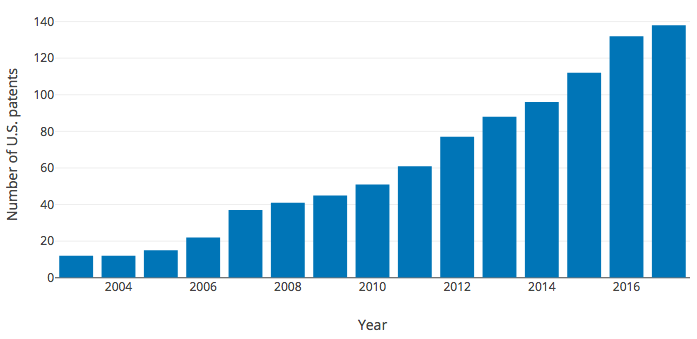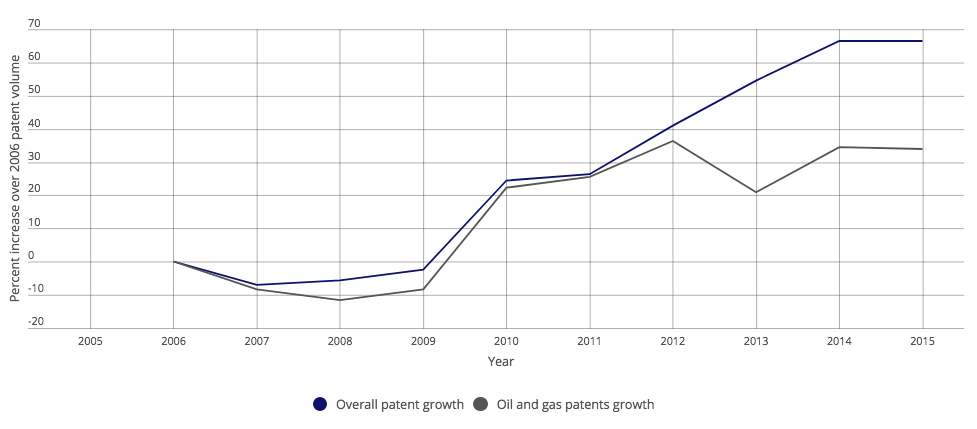In recent years, the oil and gas industry has seen a radical shift in the competitive landscape — and businesses have adjusted their strategies to follow suit.
Years ago, the industry had focused on risk management and capital as the primary means of driving growth. But over the past decade, factors like volatility in oil prices, the depletion of certain existing reserves, and mounting environmental considerations have contributed to a market-wide push to develop and protect innovative technologies. For example, MIT Technology Review recently identified zero-carbon natural gas as one of the top 10 breakthrough technologies of 2018.
If you’re in the oil and gas industry, seeking strong IP protections for innovative technology can help you stay competitive even in the face of growing market uncertainty and volatility. Here’s how the industry’s use of patents has changed over the past 15 years.

SOFTWARE-IMPLEMENTED PATENT FILINGS IN THE OIL AND GAS INDUSTRY
As injection treatment processes such as hydraulic fracturing have become more valuable, oil and gas companies have increasingly needed to use software to digitally simulate fracturing processes, so as to better understand the effects of their fracture treatments.
And as software technology has become more sophisticated over time, the industry’s ability to produce valuable computer models and other software for oil and gas systems has grown. This suggests that software patents for the oil and gas industry have become increasingly important.
Our own research corroborates this hypothesis. The number of software-implemented patents in the oil and gas industry has steadily increased over the past 15 years:
Increase in software-implemented patent activity over time

This wasn’t an exhaustive search by any means; we just did a quick sampling of issued U.S. patents based on simple keyword searching through the USPTO search interface. We did notreview the individual patents or filter for false hits. But we selected the search terms that we thought would give a representative profile of the data we wanted to examine. The absolute numbers for each year are less important than the trend year-over-year.
What’s especially interesting is that the numbers did not plateau or decrease following Alice,suggesting that the benefits of filing software-implemented patents in the oil and gas industry continue to outweigh the drawbacks.
OVERALL PATENTING TRENDS IN THE OIL AND GAS INDUSTRY
While the rate of oil and gas patent growth in general has been slowing, the rate of patent growth for specific technologies within the oil and gas industry has been exponentially growing — suggesting that major industry players have shifted their strategic focus toward protecting key technologies.
OVERALL PATENTING TRENDS
A 2015 report by Deloitte reveals that, since 2012, the rate of oil and gas patent filings have been diverging from overall patent filing trends.
Increase in patent activity over time

Source: Deloitte
The above graph shows that before 2012, both types of patent filings had generally followed the same trends: a decrease corresponding with the Great Recession of 2008, followed by a rapid increase up till 2012.
But after 2012, oil and gas patent filings have been increasing at a much slower rate than overall patent filings. According to the Deloitte report, here’s how the five-year compound annual growth rate differed:
- Oil and gas patents: 1.3 percent increase
- Overall patent universe: 5.7 percent increase
PATENTING TRENDS WITHIN KEY FIELDS OF INNOVATION
But, in contrast with the general trends discussed above, the rate of patent filings for specific fields within the oil and gas industry are actually growing faster than that of the general patent universe.
The Deloitte report identified the following areas as seeing the highest rates of increased patent filings:
- Earth drilling
- Geophysics
- Metalworking technologies
- Climate change–mitigation technologies
It’s worth noting that patent filings for earth drilling in particular have outpaced that of every other field. In 2015 alone, 1,465 earth drilling patents were granted. That’s 1,026 patents more than the next most popular field, geophysics, where 439 patents were granted. (That’s a whopping 236 percent more.)
Technologies such as metalworking have likely seen an uptick in patent filings because they connect core technologies (such as earth drilling) with other, more specialized technologies.
Incidentally, the least popular fields for patent filings are (according to the Deloitte study):
- Cracking hydrocarbon oils
- Acyclic or carbocyclic compounds
- Chemical or physical processes
KEY COUNTRIES FOR OIL AND GAS INNOVATION
The most oil and gas patent filings originated from the following three jurisdictions:
- China
- United States
- Japan
KEY PATENT HOLDERS IN THE OIL AND GAS INDUSTRIES
No surprise to folks in the industry — these three companies filed the largest number of patents in the industry in 2017:
- Halliburton: 738
- Baker Hughes: 496
- Schlumberger: 434
HIRE A PATENT PROFESSIONAL WHO UNDERSTANDS THE OIL AND GAS PATENT LANDSCAPE
Based on the above statistics, it’s clear that oil and gas companies need to hire patent professionals who understand both the oil and gas industry and associated software technology.
Henry Patent Law Firm’s team has extensive experience with filing patent applications in both fields. Our principal, Michael Henry, did patent work for Halliburton for eight years — including work on downhole logging tools, flow control devices, and other types of downhole production technology. He’s also written scores of patent applications for computer modeling of injection treatments, including hydraulic fracturing treatments.

Michael K. Henry, Ph.D.
Michael K. Henry, Ph.D., is a principal and the firm’s founding member. He specializes in creating comprehensive, growth-oriented IP strategies for early-stage tech companies.

